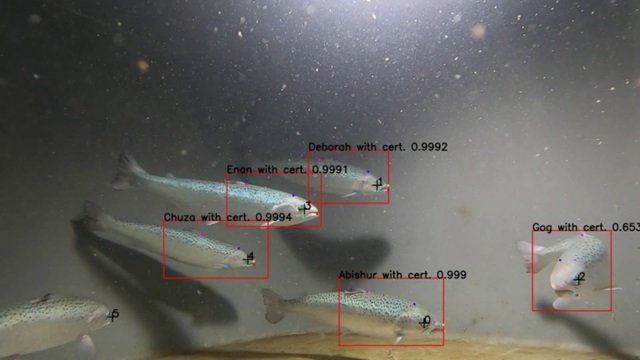
Feeding practices are the cornerstone of aquaculture success, and given that fish needs constantly change, smarter feeding systems are necessary.
Scientists from the Hellenic Center for Marine Research published a study addressing the critical gap in feeding control systems in sea cages. They introduce a real-time continuous tracking system to analyze the feeding behavior of European sea bass, employing advanced AI models (YOLO and DEEPSORT) and computer vision techniques.
This groundbreaking study tackles a key challenge in sea cage aquaculture: the lack of real-time feeding control. It introduces a revolutionary system that utilizes advanced artificial intelligence (AI) to continuously monitor and analyze the feeding behavior of European sea bass.
- 1 The challenge: Traditional feeding methods
- 2 The solution: Smarter feeding system with AI cameras
- 3 Testing the system with different feeding scenarios
- 4 AI for fish? Here’s how it works
- 5 Understanding fish through the eyes of AI
- 6 Uncovering the secrets of fish behavior
- 7 Benefits of AI-driven feeding
- 8 Conclusion
- 9 Entradas relacionadas:
The challenge: Traditional feeding methods
Traditional feeding methods may not account for factors such as fish size, health, or environmental conditions, leading to overfeeding or underfeeding.
Overfeeding wastes resources and pollutes water, while underfeeding hinders fish growth and overall farm profitability.
Additionally, current methods lack real-time data on the feeding needs of individual fish.
The solution: Smarter feeding system with AI cameras
The study presents a revolutionary system that utilizes:
- Single-view underwater cameras to track fish movement.
- Advanced AI models to detect and track individual fish and identify feeding activity.
It focuses on two key parameters:
- Fish speed: How active are the fish?
- Feeding Behavior Index (FBI): A new metric to quantify feeding activity.
Testing the system with different feeding scenarios
Researchers explored how fish behavior (speed and FBI) changed with variations in:
Stay Always Informed
Join our communities to instantly receive the most important news, reports, and analysis from the aquaculture industry.
- Feeding frequency: How often were fish fed?
- Feeding amount: How much food did they receive?
- Feeding duration: How long did the feeding last?
AI for fish? Here’s how it works
The system leverages the power of cutting-edge artificial intelligence models (YOLO and DEEPSORT) and computer vision techniques to provide real-time insights into fish behavior. It focuses on crucial parameters like swimming speed and a newly defined Feeding Behavior Index (FBI).
Understanding fish through the eyes of AI
Researchers monitored key parameters such as fish speed and a Feeding Behavior Index (FBI). This helped identify distinct behavior patterns based on feeding frequency, feeding time, and amount.
For example, fish showed higher activity during mornings and exhibited asymmetrical movement patterns when underfed or overfed.
Uncovering the secrets of fish behavior
The study reveals a fascinating connection between fish behavior and feeding scenarios. Here are some key findings:
- Speed and FBI are sensitive to different feeding scenarios.
- Fish exhibit distinct behavior patterns based on feeding frequency, time, and amount.
- European sea bass shows higher activity in the morning compared to later feeding hours.
- Underfeeding or overfeeding leads to asymmetrical activity patterns.
This research is among the first to develop a real-time feeding control system for sea cages; it establishes reference curves and thresholds to optimize feeding strategies based on fish behavior.
Benefits of AI-driven feeding
- Waste reduction: Precise feeding based on fish needs minimizes food waste and environmental impact.
- Fish health improvement: Customized feeding routines ensure optimal growth and overall fish welfare.
- Increased profitability: Smarter feeding practices lead to better resource utilization and higher farm yields.
Conclusion
This innovative technology represents a significant advancement in aquaculture. By understanding fish behavior, we can ensure healthy fish populations and a thriving fishing industry for the future.
By integrating AI and fish behavior analysis, this research paves the way for a more sustainable and efficient future for aquaculture. With these advancements, fish farms can optimize feeding practices, ensure healthy fish populations, and contribute to a prosperous fishing industry.
The study was funded by EU Horizon 2020.
Reference (open access)
Georgopoulou, D. G., Vouidaskis, C., & Papandroulakis, N. (2024). Swimming behavior as a potential metric to detect satiation levels of European seabass in marine cages. Frontiers in Marine Science, 11, 1350385. https://doi.org/10.3389/fmars.2024.1350385
Editor at the digital magazine AquaHoy. He holds a degree in Aquaculture Biology from the National University of Santa (UNS) and a Master’s degree in Science and Innovation Management from the Polytechnic University of Valencia, with postgraduate diplomas in Business Innovation and Innovation Management. He possesses extensive experience in the aquaculture and fisheries sector, having led the Fisheries Innovation Unit of the National Program for Innovation in Fisheries and Aquaculture (PNIPA). He has served as a senior consultant in technology watch, an innovation project formulator and advisor, and a lecturer at UNS. He is a member of the Peruvian College of Biologists and was recognized by the World Aquaculture Society (WAS) in 2016 for his contribution to aquaculture.




